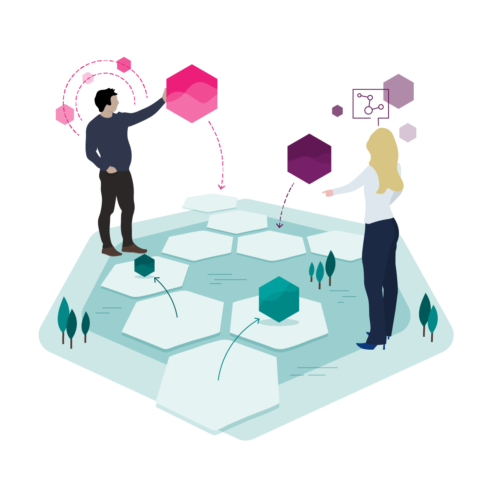Creating effective, high impact development resources…that get used!
An important dimension of our Career Strategy model is enabling personal agency. By this we mean helping individuals to develop the confidence and skills they need to own and drive their career development.
A key role for the organisation is to provide its people with relevant, genuinely useful and easy to access development resources. In this virtual roundtable we explored how you create tools that employees want to use, because they talk to their needs and the organisational context.
Michael Durrant, Senior HR Manager – Talent at Santander UK was our provocateur. Michael has extensive experience of establishing collaborative relationships with multiple stakeholders. He described how he drew on this experience, adopting an agile approach to create a Career Playbook of development resources to stretch individual capability and meet commercial needs.
Insight
David North introduced the session by outlining some of the factors that influence whether career development resources are fit for purpose:
- Are they aligned with organisational strategy and future skills requirements?
- Are they practically useful and available when people need them?
- Does the organisational culture support individuals demonstrating personal agency and self-managed career building?
‘HR aren’t always on top of this topic and actively promoting career development resources’
Participants were invited to evaluate how impactful their current resources are. In sharing their assessments they highlighted these challenges:
- Career support has not focused on the entire employee population
- Our digital support tools could be better
- There’s a lack of understanding about the opportunities that exist across the business
- Talent hoarding gets in the way of career mobility
- We lack a supportive learning culture
- The resources we do have aren’t joined up
‘We have useful resources, but they’re well hidden!’
More positive indicators of progress were also shared:
- Our leadership culture works in our favour; leaders drive regular conversations
- We are planning to use existing people development partners to support our new strategy
- We do a lot of data gathering and analysis to track how we’re doing
‘We conducted a ‘listening tour’ to better understand how we could improve our support’
Innovation
Michael started his presentation by telling us that, like other financial services companies, Santander UK is a business in transition. Their purpose is to help ‘people and the business prosper’, highlighting that employees are a key stakeholder group.
‘Engaging, motivating and developing a talented and diverse team is one of our four strategic priorities’
Santander recognises that to future proof the business it needs to future proof its people. Their EVP is honest with employees about how the business is changing, what this will mean for everyone, and the need for employees to drive their career and career development. It details the bank’s commitment in a common narrative about people development. This includes the following statements:
- We are passionate about supporting you to continuously grow
- We believe growth and innovation is enabled by continuous learning
- We want you to take time for yourself, supported by your manager and others, to agree the development and career path you want
Delivering on this promise is a business imperative for Santander. It has 20,000 employees and over 2,000 live vacancies. The company needs to connect its people to these opportunities, prepare them for new roles, and influence them to stay rather than seek a new job outside.
Michael described how he and his team tackled this challenge. In collaboration with Santander’s communication team, they listened to what their ‘customers’ had to say about the career development information they needed and where and how they wanted it delivered. The discovery and design phase featured an agile approach, underpinned by these principles:
- Engage the ‘customer’ every step of the way
- Simplify everything
- Add value quickly, and incrementally
- Think like a marketeer
Several insights guided their response: the need to shift responsibility for careers from HR to individuals and leaders, and the importance of integrating all support resources in one place so everyone knows where to go, and can get support when they need it. It’s appropriate then that their new Career Playbook can be found on a learning platform called ‘Mine’!
‘Our Career Playbook is like a tourist information centre; it’s about guiding people to find the right things to do, as they need them’
The Playbook is organised around four themes:
- Learn your drivers and get in gear
- Explore all opportunities and see what fits
- Build your capabilities and fill any gaps
- Build your portfolio to get noticed
Michael places a lot of emphasis on tracking how the Playbook impacts indicators of career development activity. He uses Peakon to provide monthly updates on measures like ‘I see a path to advance my career in our organisation’, ‘My job enables me to learn and develop new skills’ and ‘My manager or a mentor encourages and supports my development’. Responses to these items have been moving in a positive direction over the past 12 months.
Participants shared learning from their own experience:
- Providing traditional career pathways constrains people’s thinking. Instead we should focus on skill and experience building and empowering employees to find their own way forward
- Our associates get the idea of the career lattice, but they need help to actualise this in a way that benefits their career development
- We have to help people make sense of their career experiences by providing tools that facilitate reflection
- Your career messaging can reach different audiences if you are creative in leveraging your ‘internal assets’. Who are the best people to help you connect with your internal customers?
- We have to design products and services that work in the way our people want them to
‘Design thinking guides our approach’
In response to Michael’s challenge, ‘how can we help our people create time and space for growth and career development?’ the group suggested senior role modelling and stories, career weeks, and including a career-related question in regular one to ones.
Impact
Rosemary McLean highlighted The Career Innovation Company’s new suite of career development resources: Career pulse, Career trails and Career inspirer. Each tool or programme puts the learner at the centre of the development journey, and features our seven career skills model.
‘Start with the individual, not with what the organisation thinks is important’
We invited people to share the ideas they were taking away from the roundtable:
- People often want answers to career dilemmas without first clarifying what’s important to them
- Career development is strengthened by networking; people need support to build networks related to their current job, and the area they want to work in
- Keep it simple; use language that resonates with the consumers of your tools and resources
- We’re offering some great materials, but are they providing the help that employees want?
- We need to do things differently; to re-frame and reimagine the way we support people
This event has passed
Thank you to everyone who took part in this event. If you're interested in getting involved check if we have any future events planned.



